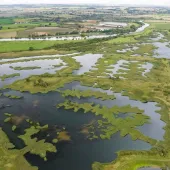Hills help fund Cotswold Water Park ecology project

CWPT receives funding for two-year Shorncote to River Thames Wetland Connection Project
THE Cotswold Water Park Trust (CWPT) has received a £70,000 grant from The Hills Group, through the Landfill Communities Fund, plus additional funding from the Environment Agency for a two-year project which is allowing a series of environmental enhancements to be carried out at two key sites in the Cotswold Water Park – Shorncote Reedbeds and Cleveland Lakes – and creating a better ecological connection between them by enhancing Cerney Wick Brook.
Shorncote Reedbeds was the first mineral site in the Cotswold Water Park (CWP) to be purposely restored as a nature reserve. A joint project between Hills Group, Thames Water and the Cotswold Water Park Society created a site with large areas of reed fringe and islands for ground-nesting birds as well as other associated wetland features. Since its inception, it has arguably become the most important site for birds in the Gloucestershire half of the CWP.
Cleveland Lakes in Wiltshire to the south is the CWPT’s largest nature reserve, where an extensive variety of wetland habitats have been created, including open water, reed beds, lagoons, mud scrapes and wet woodland.
Cerney Wick Brook, which connects the two reserves, is in poor condition with long stretches of the watercourse suffering from dense over-shading, artificial straightening and a general lack of channel diversity. It has little in the way of in-channel or marginal vegetation, and where this does exist, it is fragmented and of poor quality.
However, of all the Thames tributaries in the Cotswold Water Park, the brook is possibly the most stable in terms of flow, due to the artificial input of water from the Shorncote sewage treatment works. This presents a huge opportunity to create and sustain a vibrant, flourishing watercourse with its own permanent residents such as kingfisher, water vole and otter.
The brook is currently utilized by all these species, but merely as a navigational tool, rather than as a home. Where these species have historically colonized its entire length from the Thames upstream to Shorncote, they are now no longer resident.
The Shorncote to River Thames Wetland Connections Project is improving the ecology of the river and the habitat for fish and invertebrates, in line with the Water Framework Directive targets, through a programme of works delivering shade reduction, channel enhancement and vegetation management. The CWPT’s estates team is currently carrying out the de-shading works and will expand along the length of the river, co-ordinating with neighbouring landholders.









